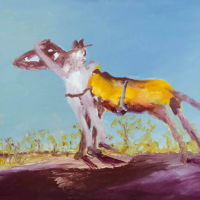35. SIDNEY NOLAN

When a vast horde of dancers wearing Ned Kelly helmets rushed onto the field for the opening ceremony of the 2000 Sydney Olympic Games, it was clear that Sidney Nolan held a dominant position in Australian art history, and indeed in the Australian imagination. From the late 1930s until his death in 1992, Sidney Nolan brought his focused vision and vivid imagination to bear on an astounding array of subject matter. The sheer breadth of his ability to conjure up new and exciting imagery drew in both his fellow artists and a broad international audience. His friend and fellow Melbourne artist Albert Tucker (1914-1999) particularly admired Nolans quick mind, lightning response and his snapshot vision, his capacity to capture and freeze the moment.1 Tuckers use of a photographic analogy was not out of place, for Nolan too had used the term to describe his own work in relation to the Eureka stockade drawings on glass, which he saw as one-off snapshots of each episode in the larger story. He had begun his working career in commercial art, making advertisements in the art department of Fayrefield Hats under the guidance of artist and illustrator Vernon Jones. In his own time he made collages from prints of all kinds, including a series of works drawn directly over stereo photographs. Nolan would come back to photographic reference material many times over the years, including the Gallipoli series of 1955 to 1961 where he used photographs of Australian soldiers swimming in the Aegean, taken from the ANZAC Book of 1916.
Nolans understanding of photography came to the fore in 1952 when he was commissioned by the Brisbane Courier Mail to document the worst drought ever experienced in Queensland. He travelled through the outback, undertaking a journey similar to that made by Russell Drysdale (1912-1981) eight years before. The toll on the outback graziers had been devastating, losing hundreds of thousands of animals through lack of food and water. All around him, Nolan saw carcasses of dead animals; cattle, sheep and, perhaps most poignantly, the station horses once prized by the graziers and stockmen. A decade earlier he had used the horse as a symbol of freedom and action for Ned Kelly and his gang, now all he saw were ghostly skeletons held together by desiccated skin and sinew. His photographs became source material for some of his most iconic outback images the distorted and tortured remains of cattle looking for all the world like the ancient victims of Pompeii. The paintings were shown in both Sydney and Brisbane in 1953, but the photographs were relegated to the news pages and the memory bank, waiting for a new moment of resurrection. One image stood out, a moment of lightness against the tragedy of drought, where his stockman-guide has thrown a saddle over a skeleton horse, perhaps echoing the popular song of the day, Ghost Riders in the Sky. The work has a power that still resonates half a century on. It marks Nolan not only as a Modernist but also as a distinct precursor to the art practices one associates with post-Modernity. Of all of Nolans vast outpouring, this photograph remains, in my mind, a work of originality, inventiveness, forward thinking and compositional panache. It is as artworks should be, utterly of its time and utterly timeless.2
Twenty-five years on, there was an awakening of interest in the photography of artists such as Albert Tucker, Russell Drysdale and Eric Thake (1904-82). Nolan chose to make a painting directly from his own photograph of the stockman and the skeletal horse. There is no doubting the source of the image, but in its re-imagining as a painting, Nolan has sought to destabilise our understanding of the original. Where Brian, the Aboriginal stockman in the photograph, holds up the horse to make the tableau, in the painting he is freed from the ground and hangs, back to the horse, which now has four feet firmly planted. Now it is the horse that supports the man, ready to move off into a landscape free from drought and care, with a strangely buoyant note cast by the magenta earth. The artist has taken us back into a memory of an earlier time, turning a humorous aside into another brick in the edifice of a mythic Australia.
Footnotes
1. Fry, G., Albert Tucker, Beagle Press, Sydney, 2005, p.33
2. Damian Smith, http://www.sidneynolantrust.org/, accessed 21 March 2018
Gavin Fry BA [Hons] MA MPhil